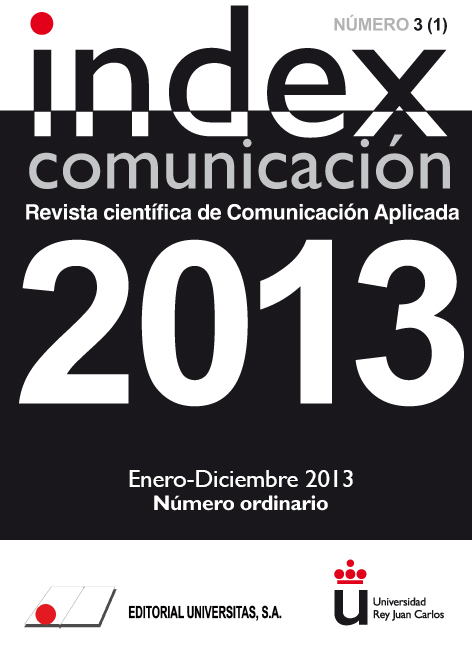Social TV Analytics: New Metrics for a New Way to Watch TV
Keywords:
Televisión social, , Televisión, Redes sociales, Twitter, EspañaAbstract
This study is part of a series of investigations conducted by FONTA, a research group at the Complutense University of Madrid. Social TV is still a little explored phenomenon in Spain. Television networks are learning to use social media for their own promotional and commercial benefit. It is a new field that requires some consideration to implement new business strategies related to the world of Connected TV. Thus, they can take advantage of opportunities that will be presented in the near future. This research focuses on the analysis of data obtained from the use and interaction of the major Spanish television channels with their respective communities of Twitter.Metrics
References
AIMC (2012): Resumen General del Estudio General de Medios (octubre 2011-mayo 2012). Recuperado el 23 de julio de 2012 desde: http://www.aimc.es
Álvarez Monzoncillo, J. M. (2011): La televisión etiquetada: nuevas audiencias, nuevos negocios. Madrid: Ariel.
Ardnt, R. Z. (2011): “Bluefin Mines Social Media To Improve TV Analytics”, en Fast Company, diciembre. Recuperado el 23 de julio de 2012 desde:
http://www.fastcompany.com/1793473/bluefin-mines-social-media-improve-tv-analytics
Bustamante, E. (1999): La televisión económica: financiación, estrategias y mercados. Barcelona: Gedisa.
Forrester® (2012): Under The Hood Of Social TV: Audio Fingerprinting: Keeping Marketing Content On Second Screens Relevant To What's On TV. Febrero. Disponible en: http://www.forrester.com
Fresno, M. del (2012): El consumidor social: reputación online y ‘social media’. Barcelona: UOC.
Futurescape (2012): “The Social TV Factor: How Social TV impacts the TV business”. Disponible en: http://www.futurescape.tv/social-tv-white-paper.html
Jansen, B. J. et al (2009): “Twitter power: Tweets as electronic word of mouth”, en Journal of the American Society for Information Science & Technology, 60 (11), pp. 2169-2188.
Java, A. et al. (2007): “Why we twitter: understanding microblogging usage and communities”, en Proceedings of the 9th WebKDD and 1st SNA-KDD 2007 workshop on Web mining and social network analysis. New York: ACM Press.
Jenkins, H. (2006): Convergence culture: Where Old and New Media Collide. London: New York University Press.
Lorente Cano, M. (2011): “Social TV en España: concepto, desarrollo e implicaciones”. Cuadernos de Gestión de Información, Vol 1, 1, pp. 55-64.
Madinaveitia, E (2012): “¿Tenemos la investigación de audiencia que necesitamos?”, en UTECA: La televisión en España, informe 2012. Madrid: CIEC.
Nielsen (2012). “The Social Media Report 2012”. Disponible en: http://www.nielsen.com/us/en/insights/reports-downloads/2012/state-of-the-media-the-social-media-report-2012.html [Recuperado el 27 de diciembre de 2012].
Orihuela, J. L. (2012): “eCuaderno: pistas, noticias y enlaces sobre los medios y la red” [blog de Internet]. Navarra: José Luis Orihuela, junio 2012 [citado el 8 de agosto de 2012]. Disponible en: http://www.ecuaderno.com
Proulx, M.; Shepatin, S. (2012): Social TV: How Marketers Can Reach and Engage Audiences by Connecting Television to the Web, Social Media and Mobile. New Jersey: John Wiley & Sons.
Roca, G. (2012): “¿Qué dice la Red de ti? Redes sociales e identidad digital”. Telos, 91, abril-junio, pp. 96-98.
Roebuck, K. (2011): “Social TV. High-impact Strategies. What You Need to Know: Definitions, Adoptions, Impact, Benefits, Maturity, Vendors”. [s.l.]: Emereo
Sánchez Tabernero, A.; Pérez-Latre, F. J. (2012): Innovación en los medios. La ruta del cambio. Pamplona: Eunsa.
Talbot, D. (2011): “A Social-Media Decoder”. Technology Review, noviembre-diciembre. Recuperado el 24 de julio de 2012 desde:
http://static.bluefinlabs.com/website/bluefin_mit-tech-review.pdf
The cocktail analysis (2013): Televidente 2012. Diciembre.
Twitter (2013): Tune in with Twitter: driving discovery and engagement with TV. Enero. Disponible en: https://tweet.twitter.com/TVbook
Downloads
Published
How to Cite
Issue
Section
License
Authors who submit to this journal agree to the following terms:
Authors retain copyright and ensure the magazine's right to be the first publication of the work as licensed under a Creative Commons Attribution-NoComercial 4.0 International License that allows others to share the work with an acknowledgment of authorship of the work and the initial publication in this magazine, with no commercial purpose.
Authors can establish separate additional agreements for non-exclusive distribution of the version of the work published in the magazine (for example, to an institutional repository or publish it in a book), with an acknowledgment of its initial publication in this journal.
It allows and authors are encouraged to disseminate their work electronically (eg, in institutional repositories or on their own website) prior to and during the submission process, as it can lead to productive exchanges, as well as a citation more early and most of the published work (See The Effect of Open Access).















